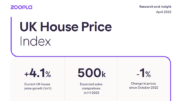Landlords and property investors are watching closely after September delivered the highest volume of new listings so far in 2025. According to eXp UK, an average of 81 homes hit the market each day last month, totalling more than 2,400 instructions. For buy-to-let investors, the spike raises questions about tenant choice, rental yields, and how any Autumn Budget changes could shift buyer appetite.
UK housing supply outpaces summer slowdown
The uptick represents a 19% jump on August instructions, reversing the seasonal dip seen between July and August, when activity fell by 6%. To put the numbers in perspective, the previous 2025 peak stood at 72 new listings per day in May and June. September has not only beaten that, but surpassed all other months this year.
Adam Day, Head of eXp UK and Europe, explained: “Summer is traditionally a slower period for the property market, and September often brings a post-holiday bounce as sellers return with renewed motivation. However, what is particularly striking this year is that the listings activity seen over September hasn’t just outpaced the summer lull, it has exceeded every month of 2025 to date.”
For landlords, increased supply means greater competition when re-letting, especially in cities where tenant mobility is high. Yet more choice could also ease some affordability concerns, reducing tenant turnover risk for those offering well-maintained homes at realistic rent levels.
Buy-to-let considerations as Autumn Budget looms
Despite seller momentum, buyer activity remains muted, with many households waiting for clarity on the Autumn Budget and potential Stamp Duty changes. If tax adjustments encourage more first-time buyers, landlords could see heightened demand in entry-level property brackets.
The National Residential Landlords Association (NRLA) has long warned that constant policy speculation-whether on Stamp Duty or rental reform-creates uncertainty that stifles investment. Investors may hesitate to expand portfolios until they know where the fiscal goalposts will be set.
Market commentators note that if transactions pick up post-Budget, landlords who secure properties now may benefit from stronger yields before renewed competition pushes prices higher. On the other hand, a continued stand-off between sellers and buyers could keep sales sluggish but bolster rental demand, a scenario that often benefits landlords in high-demand regions such as London and the South East.
Regional rental dynamics and landlord outlook
While eXp UK’s data tracks national listings, the impact varies regionally. ONS figures show that average UK rents rose 8.2% in the year to August, with London leading at 9.4% annual growth. Even with more stock coming to market, constrained mortgage affordability is likely to keep many households renting for longer, sustaining demand in the private rented sector.
For landlords, the equation is clear: more homes on the market does not automatically mean falling rents, especially when higher borrowing costs deter would-be buyers. In fact, the imbalance may reinforce the role of private landlords, who continue to provide homes where social housing capacity falls short.
Editor’s view
For landlords, record seller activity in September is a reminder that markets rarely stand still. Supply is up, policy change is in the air, and tenant demand remains sticky. The winners will be those who adapt early-balancing rent levels with tenant retention while scanning the Budget for opportunities.
Author: Editorial team - UK landlord & buy-to-let news, policy, and finance.
Published: 2 October 2025
Sources: eXp UK internal market data (September 2025); ONS Private Rental Index (August 2025); NRLA commentary.
Related reading: Landlords track steady house price gains with north ahead of south








